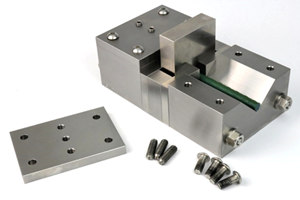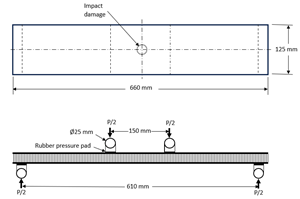Crashworthiness testing of composites: A building block approach, Part 2
Following the previously discussed coupon-level testing element, subcomponent and component testing are the next steps in designing crashworthy composite structures.
Share
Figure 1. Building block approach for crashworthiness-related testing associated with composite structures. Source (All Images) | Dan Adams
In my November 2024 column, I began discussing the building block approach for crashworthiness testing of composite structures. This approach features a multistep process for designing composite structures with crashworthiness requirements, in which the complexity of testing increases and the number of tests decreases. The building block pyramid shown in Fig. 1 illustrates the first four levels of crashworthiness testing associated with a composite transport aircraft structure.
Previously, I focused on the initial coupon-level crush testing used to identify composite laminates and ply stacking sequences that produced high crush stress and energy absorption values. From this testing, two carbon fiber/epoxy laminates, [902/02/±45/02]S and [90/+45/02/90/-45/02]S, were identified for use in element-level testing. These flat-coupon crush test results also were of use in establishing crush properties and modeling parameters associated with specific finite element analysis (FEA) methodologies. However, the quantity and types of coupon-level crashworthiness testing are dependent on the numerical modeling approach being used.
Following flat-coupon crush testing, test results from the two selected composite laminates were provided to Crashworthiness Working Group members for use in performing finite element analyses of the initial coupon-level crush tests. These initial coupon-level crush simulations were also used for establishing modeling parameters and crush-related properties for use in predicting progressive crushing at higher building block levels.
In this column, I’ll focus on the crashworthiness testing associated with the element, subcomponent and component levels of the building block. Additionally, I’ll continue to focus on the commercial aviation industry, for which an ongoing building block exercise is being performed and documented by the Composite Materials Handbook-17 (CMH-17) Crashworthiness Working Group.1
Element-level testing
The group’s recent focus has been the element-level crush testing and numerical crush simulation of composite C-channel specimens. These specimens represent the stanchions used to support the lower cargo floor in a transport aircraft fuselage. The C-shaped cross section of the stanchions provides structural stability and permits flush attachment to adjoining structures in the aircraft fuselage. In addition to serving as structural members during normal aircraft operations, these stanchions also serve as primary energy-absorbing structural elements in the event of a crash.

Figure 2. University of Utah drop tower used for C-channel crush testing2.
Starting with element-level testing, additional emphasis has been placed on the development of predictive capabilities for crush behavior and energy absorption through the comparison of FEA predictions with crush test results. Element-level crush testing was performed using C-channel specimens fabricated using the same two composite layups as for flat-coupon crush testing. The C-channel crush testing was performed using a vertical drop tower at the University of Utah as shown in Fig. 2. A bevel-shaped trigger mechanism was machined into the top end of the specimen to initiate crush failure. Crush testing was performed using two initial impact velocities. The initial impact event and progressive crush behavior were recorded using a high-speed video camera as shown in Fig. 3. Additionally, force versus displacement data was recorded during progressive crushing for use in assessing the predictive capabilities of the various FEA methodologies being investigated.
A total of nine finite element modeling approaches were used to simulate the C-channel crush testing. Analysis teams were provided with the flat-coupon crush test results for the two laminate configurations as well as the C-channel test specimen geometry and drop-weight crush testing information. Each team performed finite element analyses using a different numerical modeling approach to predict the crush behavior and resulting energy absorption for the C-channel crush test specimens. After the analysis teams had submitted their predictions for the two sets of C-channel specimens, the experimental crush test results were distributed to all participants.
Subcomponent and component testing
Currently the CMH-17 Crashworthiness Working Group is focusing on establishing best practices for numerical modeling of subcomponent-level composite structures similar to that shown in the Fig. 1 building block. For transport aircraft, this subcomponent is an assembly of element-level structures that includes the primary energy absorbing C-channel elements from the previous building block level. Therefore, future subcomponent-level crashworthiness testing and analysis will also focus on the mechanical connections and the resulting interaction of elements within the subcomponent assembly.
Figure 3. Progressive crush behavior of composite C-channel specimen recorded using a high-speed video camera2.
In addition to assessing the crashworthiness of the proposed subcomponent configuration, subcomponent-level crush testing is used to investigate the interaction of the structural elements forming the subcomponent. Test results may also be used to ensure that the analysis methodology is properly predicting the load transfer and resulting structural element crush behavior observed during crush testing. Multiple subcomponent crush tests are typically performed when designing subcomponent-level structures for crashworthiness to ensure that the proposed structural configuration will perform as intended.
At the component level of the building block, a larger assembly of elements and subcomponents that represents a significant portion of the primary crush structure are tested and analyzed. In the current CMH-17 building block exercise, a candidate component-level test article would include a portion of the aircraft fuselage barrel as shown in Fig. 1. In addition to assessing the effectiveness of element-level energy absorbing features within the component, crush testing may also be performed to assess the connections between adjacent elements and subcomponents. Similar to the lower levels of the building block, test results are used to validate the numerical modeling approach, including the input modeling parameters and crush-related properties.
Although not shown in the crashworthiness building block in Fig. 1, a full-scale test is often performed as a final crashworthiness validation test. For transport aircraft, possible test articles include a full barrel or partial barrel section of the complete aircraft fuselage. Further information on the crashworthiness building block approach for composites is provided in Volume 3, Chapter 16 of the “Composite Materials Handbook-17 (CMH-17)1.”
References
1“Composite Materials Handbook - 17 (CMH-17),” Volume 3, Chapter 16: Crashworthiness and Energy Management, SAE International, Rev. H, 2025.
2Ostler, D. W., “Characterization of Carbon/Epoxy C-Channels for Crashworthiness Applications,” M.S. Thesis, University of Utah, May 2021.
Related Content
Composite test methods (and specifications) for fiber-reinforced concrete structures
While initially focused on transitioning existing standards published by the American Concrete Institute, the relatively new ASTM Subcommittee D30.10 is developing new standardized test methods and material specifications for FRP composites.
Read MoreCrashworthiness testing of composites: A building block approach, Part 1
Determining the crashworthiness of composite structures requires several levels of testing and analysis, starting with coupon-level crush testing.
Read MoreTesting to support composite bolted joint analysis
An overview of ASTM Standard Guide D8509, and its coupon-level mechanical testing of design properties for analyzing composite bolted joints.
Read MoreDamage tolerance testing of sandwich composites: The sandwich flexure-after-impact (FAI) test
A second new ASTM-standardized test method assesses the damage tolerance of sandwich composites under flexural loading.
Read MoreRead Next
Crashworthiness testing of composites: A building block approach, Part 1
Determining the crashworthiness of composite structures requires several levels of testing and analysis, starting with coupon-level crush testing.
Read MoreModeling and characterization of crushable composite structures
How the predictive tool “CZone” is applied to simulate the axial crushing response of composites, providing valuable insights into their use for motorsport applications.
Read MorePlant tour: Daher Shap’in TechCenter and composites production plant, Saint-Aignan-de-Grandlieu, France
Co-located R&D and production advance OOA thermosets, thermoplastics, welding, recycling and digital technologies for faster processing and certification of lighter, more sustainable composites.
Read More
















